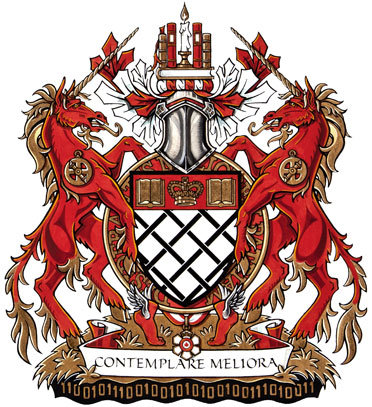 Arms
Arms
The pattern of interlaced diagonal stripes symbolizes the central role of family and other relationships in Mr. Johnston’s life, as well as his interest in communication networks and his belief in the interconnectedness of knowledge. As these stripes are set at evenly spaced intervals and cross each other in a particular pattern, the design alludes to the importance that Mr. Johnston places on the ideas of order and organization. The Royal Crown indicates that he is the Sovereign’s representative. The books, also shown in the crest, refer to reading and writing and the written transmission of knowledge. They also symbolize the law, which is codified in written records. The colours and the general structure of the arms are found in other Johnston arms from Scotland.
An annulus inscribed with the motto of the Order of Canada, DESIDERANTES MELIOREM PATRIAM, meaning “They desire a better country”, encircles the shield, and the insignia of a Companion of the Order of Canada is suspended from the shield.
Crest
The candle symbolizes not only learning and enlightenment but also the transmission of learning from one person to another. The books repeat the symbolism from the arms. Shown here as volumes on a shelf, they represent the acquisition of knowledge from many sources. Their number refers to Mr. Johnston’s five daughters.
Motto
The Latin phrase CONTEMPLARE MELIORA, meaning “To envisage a better world” (literally “To envisage better things”), alludes to a line from George Bernard Shaw’s play Back to Methuselah (Part I, Act I): “You see things; and you say, ‘Why?’ But I dream things that never were; and I say, ‘Why not? ’”.
Supporters
Being fantastical beasts, the unicorns represent dreams, vision, and imagination. They are also a Christian symbol and an emblem of purity, and can therefore represent integrity and faithfulness. Their red colour represents Canada. The astrolabes on their shoulders are symbols of exploration, including the idea of intellectual exploration. They allude to the history of Canada, especially to Samuel de Champlain, who used such an astrolabe. The winged feet, an attribute of Hermes, evoke physical activity, fitness and sports, in addition to being a symbol of communication. The wavy band inscribed with zeros and ones represents a flow of information, digital communication and modern media.
